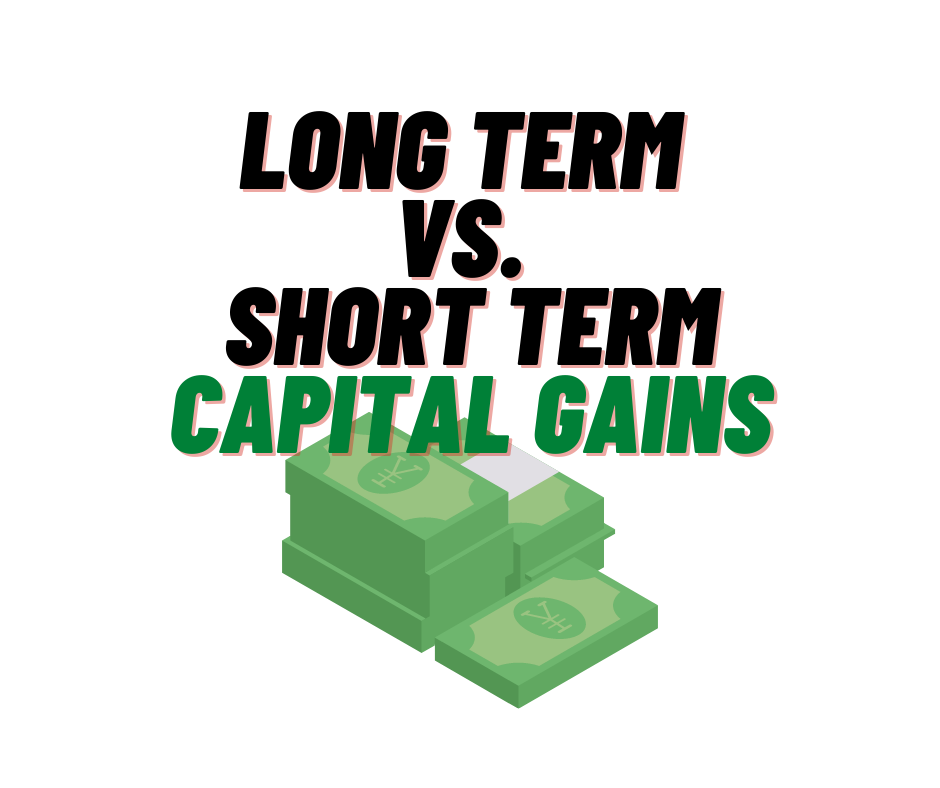Long Term vs. Short Term Capital Gains Taxes Explained

Bottom Line Up Front (BLUF): You pay capital gains taxes on investment earnings/profits each year (but not in Roth IRA, IRA, 401K, or TSP). Long Term Capital Gains insurance are taxed in tiers (i.e. buckets), starting at 0% with many paying 15%. Short Term Capital Gains are taxed as regular income (usually at a higher tax rate than long term gains).
First off, I’m not a tax professional. Seek other resources or professional tax advice, especially if there are significant money on the line. However, my hope is to help people understand how capital gains taxes work so that they can make tax-smart decisions with their investments.
What are capital gains taxes?
Capital gains taxes are taxes on the profits from your investments. Profits are calculated based on the difference between your investment’s cost basis (i.e. how much you paid) and the sale price.
Capital Gains = investment profits
You only pay taxes on capital gains when you sell your investments. This includes selling stocks, bonds, jewelry, coin collections, real estate, and cryptocurrency. (For crypto, you also pay every time you swap coins/tokens.)
However, you don’t pay Capital Gains in Retirement Accounts…
You don’t pay capital gains taxes when you sell stocks/bonds/investments inside a retirement account, like IRAs or TSP. In a traditional IRA or TSP, you’ll only pay taxes when you distribute (i.e. pull money out) from your IRA or TSP.
If your money is in a Roth IRA or Roth TSP, you won’t pay any taxes at all on your investment gains! (It’s why these are considered such critical parts of your retirement plan.)
What’s the trade-off? You take penalties if you pull money of out retirement accounts too early. The exception is with a Roth IRA, which allows you to pull out your contributions (i.e. only the money you put in, not the investment earnings/profits) before retirement age.
Read this article about the tax benefits of IRAs and Roth IRAs for more details.
Long Term vs. Short Term Capital Gains
In short: If your investments are in a regular brokerage account (i.e. a regular investment account with a company like Schwab, Vanguard, or TD Ameritrade), you have to pay taxes on your gains each year.
However, you pay different tax rates depending on how long you’ve held your investment:
- Long Term: Over 1 year
- Short Term: 1 year or less
Long term are taxed with special tax rates (which usually are lower). See below for more details.
Short term capital gains are taxed as regular income (i.e. your regular tax brackets). It just increases your income on your taxes. Read this article for a simple of breakdown of how tax brackets work.
Also, for investments that pay dividends (like stocks and bonds), dividends are also taxed as regular income for most taxpayers.
Your investment company should provide tax records that calculate your capital gains. However, if you invest in crypto, you have to document and track all of your trades yourself.
Capital Losses
When you sell an investment for less than what you bought it for, you have a capital loss. These losses offset (i.e. subtract from) your capital gains during that year.
How are Long Term Capital Gains Taxed?
Long term capital gains are taxed based on your total taxable income (also known as your Adjusted Gross Income, or AGI). When you file your taxes, AGI is your income minus all tax deductions.
AGI = Income (including Investment Gains) - Deductions
Once you have an idea of what your AGI will be (estimate if you have to), compare your AGI to the chart below to see what long-term capital gains rate you will likely pay:
| 2022 Long Term Capital Gains Tax - by Income Level | |||
| FILING STATUS | 0% RATE | 15% RATE | 20% RATE |
| Single | Up to $41,675 | $41,676 – $459,750 | Over $459,750 |
| Married filing jointly | Up to $83,350 | $83,351 – $517,200 | Over $517,200 |
| Married filing separately | Up to $41,675 | $41,676 – $258,600 | Over $258,600 |
| Head of household | Up to $55,800 | $55,801 – $488,500 | Over $488,500 |
| Source: Bankrate |
For example, if you are a single member who’s Adjusted Gross Income (AGI) is $80,000, you’ll pay 15% on all long-term capital gains that year.
However, if you are married member (filing jointly) whose AGI is $80,000, you’ll pay 0% on all long-term capital gains that year.
Thankfully for military members, our AGI tends to be lower (because our BAS/BAH entitlements are tax-free). However, selling too many investments in brokerage accounts (or crypto) in one year can force you to pay taxes on your gains.
So, why did I write this post?
When you start investing heavily, avoiding taxes (legally) becomes a major concern. By understanding capital gains taxes, you understand the risks of investing in brokerage accounts (i.e. you pay taxes on sales each year) vs. retirement accounts (i.e. you may not be able to access the money).
As Robert Kiyosaki, the author of “Rich Dad, Poor Dad” says, “It’s not how much you make, but how much money you keep…” Minimize your tax burden to keep more of your investment gains.
In the future, I intend to write a long multi-part post about creating your family’s own financial plan. Having a good plan that accounts for taxes is a critical step in protecting your investments and future wealth. More to come!